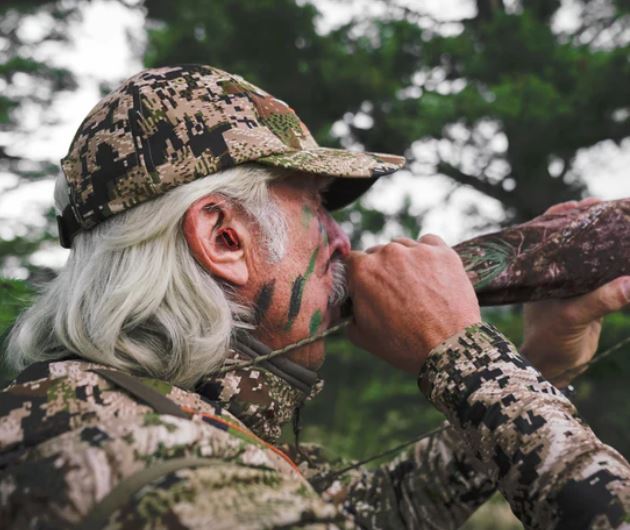Why Hearing Protection for Elk Hunting Season?

Hearing Protection for Elk Hunting Can Help You Fill Your Tag
There’s something primal about spending significant time outdoors, but that’s especially true when you’re elk hunting in the mountains. And what’s more iconic and spine-tingling than hearing a big bull elk bugling on a distant ridge on an early, frosty morning? It’ll send a shiver down your spine and put every sense you have on high alert. Probably more so than natural predators (e.g., wolves, bears, etc.), we rely on our sense of hearing to pinpoint elk locations, scout possible ambush sites, and get within range. Besides our vision, it’s our most important sense for elk hunting. So why don’t we talk about hearing protection for elk hunting more often? Here are some reasons why you should consider using it, and how it could actually help you fill your tag and freezer.
How Loud are Elk Bugles?
Each fall, bull elk sure know how to impress their cows (and us too). Starting in late August or early September (in different parts of the country), the sound of bugling will start to fill the western skies as the rut kicks off. Territorial bulls get very vocal when trying to show off for their harem, and will aggressively defend their breeding rights against other bulls. Rocky Mountain elk produce a characteristic high-frequency bugle that can reach 90 decibels (dB) at 5 meters away, which is actually quite loud (Titze and Riede 2010). With the right conditions and topography, these calls can be heard for miles away. That’s why they are so effective for elk communication, and why it’s so important for us to pay attention to where they’re coming from.
Now imagine hunting elk without having your sense of hearing. Can it be done? Absolutely. But what if you entered a new valley and couldn’t hear where the bulls were located? It would take a lot more glassing from ridges or hiking up each draw to find them. That can be effective too, but it sure isn’t as efficient as hearing a bugle and knowing which direction to start in and approximately how far away they are. For that reason, bugling is obviously a great indicator of where the bulls are, so it can streamline your hunting approach tremendously. Thinking more about hearing protection for elk hunting yet?
Hearing Protection for Elk Hunting
Elk are some of the largest big game animals we can hunt in North America – besides the moose, they are the next biggest species in the deer family. As such, you need a good high-powered centerfire rifle to ethically put them down fast. Popular elk hunting calibers include the .270 or .30-06 as they offer just the right amount of range and knockdown power for a big animal. However, both of these guns produce very loud gunshots – on average, they are both capable of making noise well above 160 dB. Since human hearing can be damaged at noise levels above only 85 dB, that’s obviously quite dangerous. You might say to yourself that you’ve done it all your life and one more shot can’t do that much damage. But the truth is that if you’re not wearing hearing protection for elk hunting, even one shot can do permanent damage to your hearing. Granted, you’re not typically shooting a lot when you’re elk hunting (maybe you’ll make two shots if you need to take a follow-up). But why damage your ears unnecessarily when you could just wear hearing protection while hunting?
Understandably, the reason many hunters tend to ignore hearing protection for elk hunting (e.g., ear plugs, ear muffs) in the field is that it interferes with the experience and hearing what’s happening around you. For example, it’s pretty hard to whisper to your hunting buddy when elk are at close range if you have ear muffs on. Likewise, you might not hear a bull elk trying to slip past you when it chooses to stop bugling, and that could cost you a shot. It’s just hard to be a predator relying on their senses when you’re actively blocking one of your most important ones.
When most people think of hearing protection for elk hunting, they assume it only relates to hearing preservation. But it can also involve sound amplification. The trick is amplifying only the sounds you want to hear while still protecting your ears from the very loud noises (i.e., gunshots). This is where the TETRA hearing devices can shine. These in-ear devices are comfortable to wear and let you hear everything going on around you. In fact, they even amplify and enhance certain sounds. For example, our Elk AmpPods are specifically optimized to amplify critical elk vocalizations. This will help you improve your early detection of the herd, and judge the distance and direction more accurately. Our Specialized Target Optimization™ (STO) technology accentuates elk bugles and barks, while keeping other sounds at clear, natural-sounding levels. Other products will over-amplify every sound, resulting in a lot of buzzing white noise in your ear instead of clear, crisp elk calls.
On a practical level, you can use this technology very effectively. Imagine setting up on a hillside after hearing a bull bugling repeatedly. As you get closer, you blow an elk bugle yourself and immediately stop to listen. Our AmpPods can help you pinpoint where the bull is and monitor his location as he approaches you (assuming he is fired up and wants to fight). As he gets within sight, you don’t need to fiddle with getting any earmuffs over your head – you just need to focus on the shot.
To summarize, our Elk AmpPods or Multi-Pursuit products help you key in on elk vocalizations, allowing you to hear everything around you in crystal clear detail, but as soon as a gunshot occurs, they instantaneously block the sound to protect your hearing. Our goal at TETRA is for you to be able to #HEARTHEUNT every time you go outdoors, now and many years down the line. So if you haven’t used hearing protection for elk hunting before, don’t delay any longer. Elk hunting wouldn’t be the same without hearing that majestic bugling echoing off a distant hilltop.
- Tags: You Heard It First
0 comments




